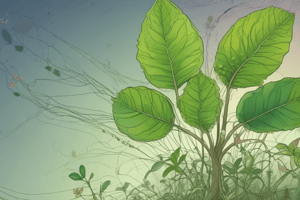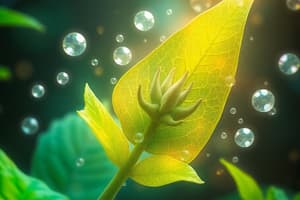Podcast
Questions and Answers
What is the primary function of xylem in plants?
What is the primary function of xylem in plants?
- Transporting nutrients and sugars throughout the plant
- Supporting the plant structure against gravity
- Storing food and water in the roots
- Transporting water and dissolved minerals up the stem (correct)
Which statement accurately describes the structure of xylem vessels?
Which statement accurately describes the structure of xylem vessels?
- Xylem vessels are narrow to maximize capillary action (correct)
- Xylem vessels are alive and filled with nutrients
- Xylem vessels have large vacuoles to aid in storage
- Xylem vessels contain chloroplasts for photosynthesis
What property of lignin in xylem contributes significantly to its function?
What property of lignin in xylem contributes significantly to its function?
- It helps in the photosynthesis process within xylem
- It provides waterproofing and mechanical strength (correct)
- It allows cells to remain alive to transport water
- It makes cells flexible and capable of storing water
What characteristic is unique to sieve tube cells in phloem?
What characteristic is unique to sieve tube cells in phloem?
How does ground tissue primarily contribute to the plant’s overall structure?
How does ground tissue primarily contribute to the plant’s overall structure?
What is the primary role of phloem in plants?
What is the primary role of phloem in plants?
Which feature distinguishes the vascular bundles in monocot leaves from those in dicot leaves?
Which feature distinguishes the vascular bundles in monocot leaves from those in dicot leaves?
What is the purpose of stomata in the epidermis of leaves?
What is the purpose of stomata in the epidermis of leaves?
In the context of plant tissues, what role does ground tissue primarily serve?
In the context of plant tissues, what role does ground tissue primarily serve?
What is the name of the stalk that connects the leaf blade to the stem?
What is the name of the stalk that connects the leaf blade to the stem?
What term describes the structure in the stem which allows for vegetative reproduction in strawberries?
What term describes the structure in the stem which allows for vegetative reproduction in strawberries?
In older plants, what additional layer can form over the epidermis for insulation and protection?
In older plants, what additional layer can form over the epidermis for insulation and protection?
Which part of the leaf forms the largest vein that runs up the center?
Which part of the leaf forms the largest vein that runs up the center?
What type of plants are mainly characterized by being pollinated by wind and having small, dull flowers?
What type of plants are mainly characterized by being pollinated by wind and having small, dull flowers?
Which function is performed primarily by leaves during their lifecycle?
Which function is performed primarily by leaves during their lifecycle?
Study Notes
Plant Cells and Tissues
- Chloroplasts are present in plant cells, where photosynthesis primarily occurs.
- Ground tissue serves multiple functions: storage of food and water in stems and roots, protection by filling space, and providing support to non-woody plants through turgidity.
Vascular Tissue
- Comprised of complex structures including Xylem and Phloem.
Xylem
- Xylem vessels are narrow, maximizing capillary action; found in angiosperms.
- Mature xylem vessels are heavily lignified for strength, enabling them to withstand water transport tension.
Tracheids
-
Thickened with lignin, making them waterproof and strong; these cells are dead and contain no cell contents.
-
Tapered ends and perforations facilitate the movement of water and minerals; lignin is absent in pits to allow lateral water movement.
-
Function of Xylem: Transports water and minerals upward in the stem and provides structural support against gravity.
Phloem
- Composed of sieve tube cells that lack a nucleus, ribosomes, and other large cell structures; transports food and materials in both directions.
- Some plants, like potatoes, use stems for food storage; strawberries reproduce vegetatively through runners.
Leaf Structure and Function
-
Composed of a petiole (stalk) and lamina (blade); vascular bundles create raised veins.
-
Leaves have varied vein structures; monocots feature parallel veins, dicots have branched veins.
-
The midrib runs centrally; the angle between the petiole and stem is called the axil, housing the axillary bud.
-
Leaf Functions: Primary role in photosynthesis, with a large surface area for maximum light capture; some leaves store food (ex: cabbage, onion) and excrete waste through shedding.
Floral Structure
- Flowers are organs of sexual reproduction, often large and colorful to attract pollinators; smaller flowers typically rely on wind for pollination.
Dermal Tissue
- Acts as the protective outer layer; in older plants, cork may insulate and protect.
- Stomata in leaves permit gaseous exchange and transpiration; woody stems have lenticels for gas exchange.
Ground Tissue
- Functions include photosynthesis through spongy and palisade mesophyll layers in leaves.
Blood Vessels
- Three primary types: Arteries, Capillaries, and Veins.
Arteries
- Small lumen, thick walls composed of collagen and muscle; carry oxygenated blood (except pulmonary artery) away from the heart.
- Blood flows rapidly and under high pressure; no valves are present.
Veins
- Larger lumen, thin walls; transport deoxygenated blood (except pulmonary vein) to the heart.
- Blood flow is slow and aided by valves to prevent backflow and maintain a steady rate.
Capillaries
- Tiny lumen, with walls only one cell thick (endothelium) for material exchange; can carry both oxygenated and deoxygenated blood.
- Blood flow is slow to facilitate exchange processes; no pulse is evident.
Arterioles
- Small arteries that branch out from larger arteries, serving as connections to capillaries.
Studying That Suits You
Use AI to generate personalized quizzes and flashcards to suit your learning preferences.
Related Documents
Description
This quiz explores the functions and structures of various plant tissues, including ground tissue and vascular tissue. Key concepts such as photosynthesis in chloroplasts and the roles of xylem and phloem will be covered. Test your knowledge of plant biology and how different tissues contribute to plant health.




